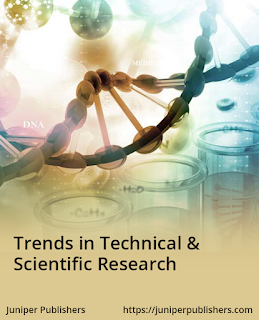Maternal Hyperthyroidism and Pregnancy Complications-Juniper Publishers
JOURNAL OF SCIENTIFIC & TECHNICAL RESEARCH JUNIPER PUBLISHERS
Commentary
The normal variations in the levels of maternal
Thyroid Hormones (THs) throughout gestation are required for the normal
development [1-60], in particular the metabolic homeostasis [60-62]. On
the other hand, [63-75] classified the hyperthyroidism into three types
as the following:
a. Thyrotoxicosis rising from the thyroid.
b. Overt hyperthyroidism is found when the
concentration of the Thyroid-Stimulating Hormone (TSH) is in the normal
range and the concentrations of the 3,5,3'-triiodothyronine (T3) and
free or total Thyroxine (T4) are above the normal range.
c. Subclinical hyperthyroidism is found when the
concentration of the TSH is under the normal range and the
concentrations of the T3 and free or total T4 are in the normal range.
As well, Glinoer [76] and [77-83] revealed that the
Human Chorionic Gonadotropin (HCG) can stimulate the TSH receptor and
cause Gestational Transient Thyrotoxicosis (GTT). Other etiologies of
thyrotoxicosis during gestation including the following:
a. Hyperthyroidism of trophoblastic disease or symptomatic hyperthyroidism [84-91];
b. Disturbances in the genomic duplication of
monospermic or dispermic fertilization and damage in the maternal
nuclear genome [92];
c. Exogenous TH, thyroiditis, toxic adenoma, toxic
multinodular goiter, and Graves' disease [93,94]. Hyperreflexia,
anxiety, tachycardia, heat intolerance, goiter, lack of weight gain, and
palpitations are the most symptoms and signs of gestational
thyrotoxicosis [95,96]. The signs of Graves' disease are ophthalmopathy
or the presence of a goiter [97,98]. In dissimilarity, the symptoms of
GTT are related to the persistent vomiting of hyperemesis gravidarum
[99,100].
On the other hand, number of examinations has
revealed a relationship between the hyperthyroidism and an increase in
the risk of pregnancy complications [101]. These complications were
including the congestive heart failure, pre-eclampsia, miscarriage,
pre-term delivery, hypertension or postpartum thyroiditis (thyroid
inflammation). Also, intrauterine growth restriction and failure in
neonatal growth are also associated with the goiter formation and
maternal hyperthyroidism. More importantly, the elevation in the
transportation of maternal TSH Receptor AntiBodies (TRAb) through
placenta and lactation to fetuses and neonates can cause fetal and
neonatal Graves' disease [102]. These disorders may delay the maternal
and fetal outcomes. Thus, the prenatal care, antithyroid medications,
and assessing TRAb levels at the late pregnancy may decrease these
complications. Also, detection the nature and duration of the GTT
symptoms may aid in the diagnostic decisions. Overall, the variations in
the signs and symptoms of gestational hyperthyroidism make experimental
studies essential.
For more Journals in Juniper Publishers please
click on https://juniperpublishers.com/journals.php
For more articles in Journal of Trends in
Technical & Scientific Research please click on https://juniperpublishers.com/ttsr/index.php


Comments
Post a Comment